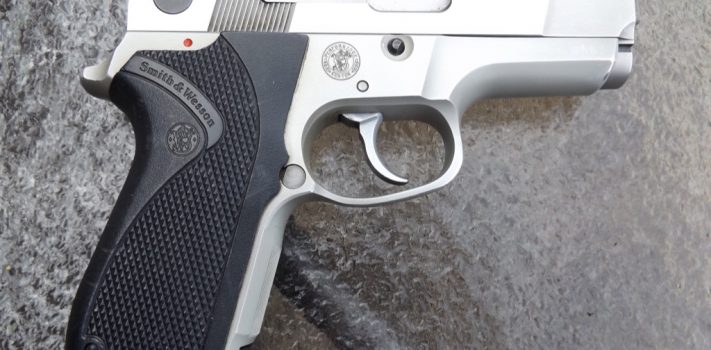I used to be a huge fan of Smith & Wesson handguns. At one time, they were my preferred handgun for duty and concealed carry. However, after several bad experiences with their customer service/repair shop, I rarely look at S&W handguns these days. S&W used to have one of the best customer service departments bar none. So, these days, I don’t look at many of their handguns.
I remember when S&W came out with their Model 469, 9mm handgun. It was a winner in my book. At the time, they were a compact pistol, that held a lot of ammo – 12+1 rounds, and they were a great concealed carry pistol – light-weight, compact and reliable. Over the years, S&W made a number of improvements and came out with second generation and third generation models. One of the best improvements was upgraded sights, in particular the rear sight. The earlier models had a very small, rounded-off rear sight, and they were hard to pick-up quickly. The newer generations had a much nicer, combat rear sight/ This made a huge difference in speed shooting. Of course, we had the three white dot aiming system, and that helped for faster and more accurate shooting as well. The trigger pull was another improvement – the trigger pull on the original 469 models were “okay” at best, but the later generation pistols had a much nicer trigger pull.
When the .40 S&W caliber came on the scene, everyone was quick to jump on this round, and S&W started producing some of their little 469 models in .40 S&W. Nice guns, with the exception that, for the most part, all S&W did was install a bigger barrel, in .40 S&W and made a few changes to the magazines, and they only held 10-rds of .40 S&W instead of 12-rounds of 9mm. The recoil spring was a bit stouter as well. The .40 S&W is a punishing round in a little gun – a lot of recoil, to say the least. Many shooters couldn’t accurately shoot the little .40 S&W guns because of the “kick” and soon traded them off.
For some time, back in the early 1990s, people were actually poking fun at S&W because of all the new models of handguns they came out with. Many people, myself included said they were the “gun of the week” – because it seemed like S&W was coming out with new models every week.
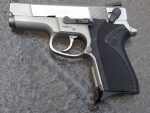 A couple of years ago, I happened to spy a used S&W “Shorty .40” as they were being called, and this one was being made in the S&W Performance Center custom shop. As I understand it, the Performance Center only produced around 500 of these guns, and mine was outstanding in all respects, compared to the regular factory version. I, of course, made a deal and snapped-up this Performance Center gun.
A couple of years ago, I happened to spy a used S&W “Shorty .40” as they were being called, and this one was being made in the S&W Performance Center custom shop. As I understand it, the Performance Center only produced around 500 of these guns, and mine was outstanding in all respects, compared to the regular factory version. I, of course, made a deal and snapped-up this Performance Center gun.
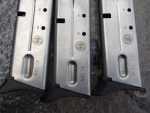 The only problem was, it only came with just one 10-round magazine, and it took me forever to find a couple more spare mags, and I didn’t want just any ol’ magazines, I wanted ones that were stamped, on the body, that they were from the Performance Center, to match. I ended up paying $40 each for two more spare magazines. Long-time readers will know that I advocate carrying at least one spare magazine any time you are packing your gun.
The only problem was, it only came with just one 10-round magazine, and it took me forever to find a couple more spare mags, and I didn’t want just any ol’ magazines, I wanted ones that were stamped, on the body, that they were from the Performance Center, to match. I ended up paying $40 each for two more spare magazines. Long-time readers will know that I advocate carrying at least one spare magazine any time you are packing your gun.
The Performance Center shop didn’t mark these guns with anything other than a stamp on the side, that said they came from the Performance Center – no model number. On the opposite side of the gun, it had a serial number that started with “PC” as the prefix, followed by other numbers. As you will see in the photos, I had a very low serial number. These guns only came in stainless steel. Well, the slide was stainless, while the frame is forged Aluminum.
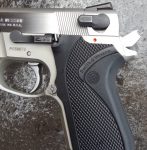 On top of the slide, we have the combat rear sight, and the sighting system is the three-dot white dots. The grips are a one-piece affaire, the early models of the 469 were a two-piece set-up…the one-piece is much better. The grips were made out of Delrin and were almost bulletproof, too. The front of the trigger guard is squared off and the front of it is checkered. The trigger pull is S.A./D.A. (Single Action/Double Action) and the trigger face is smooth. When you chamber a round, the bobbed hammer stays cocked – you don’t want that! So, you use the safety/de-cocker lever to lower the hammer. Then, when you are ready to fire your first round, it is a long, but very smooth D.A. trigger pull. After that, all rounds are fired S.A. – you have to keep in mind that, because this is a Performance Center shop custom gun, the trigger pull is much better than the standard factory gun.
On top of the slide, we have the combat rear sight, and the sighting system is the three-dot white dots. The grips are a one-piece affaire, the early models of the 469 were a two-piece set-up…the one-piece is much better. The grips were made out of Delrin and were almost bulletproof, too. The front of the trigger guard is squared off and the front of it is checkered. The trigger pull is S.A./D.A. (Single Action/Double Action) and the trigger face is smooth. When you chamber a round, the bobbed hammer stays cocked – you don’t want that! So, you use the safety/de-cocker lever to lower the hammer. Then, when you are ready to fire your first round, it is a long, but very smooth D.A. trigger pull. After that, all rounds are fired S.A. – you have to keep in mind that, because this is a Performance Center shop custom gun, the trigger pull is much better than the standard factory gun.
The bobbed hammer is there so that the hammer won’t snag on clothing when drawing the gun – a nice touch. However, many holsters with a safety strap were sloppy when you snapped it – because there was that little bit of room because the hammer was bobbed. Not a deal-breaker, because I carried in a pancake-style holster with no safety strap. In keeping with a slim and trim design, the single-sided magazine release is small – easy to miss it, when you want to do a fast reload – ugh! The front strap on the frame was just serrations, running up and down the front strap. The safety/de-cocker is only on the left side of the frame. The slide release/stop is pretty much factory standard, but large enough to release it with your thumb on your firing hand. This is NOT a gun suitable for a left-hander!
 The stainless steel barrel is 3.5-inches long and we have a Briley Spherical barrel bushing inside of the frame, that makes the gun a lot more accurate than the standard set-up. As you look at the barrel from the front – unloaded gun, of course, you can see the gold colored bushing. All things considered, this Performance Center shop gun was nicely fitted. I understand that the Performance Center Shop started out with an over-sized frame and slide, and then fit them together for a match-grade fit – outstanding set-up. They didn’t simply start out with a factory gun and then work on them – nope, not at all. Each piece was fitted to each gun – no reaching in a parts box and simply installing a part – each part was fitted to each gun.
The stainless steel barrel is 3.5-inches long and we have a Briley Spherical barrel bushing inside of the frame, that makes the gun a lot more accurate than the standard set-up. As you look at the barrel from the front – unloaded gun, of course, you can see the gold colored bushing. All things considered, this Performance Center shop gun was nicely fitted. I understand that the Performance Center Shop started out with an over-sized frame and slide, and then fit them together for a match-grade fit – outstanding set-up. They didn’t simply start out with a factory gun and then work on them – nope, not at all. Each piece was fitted to each gun – no reaching in a parts box and simply installing a part – each part was fitted to each gun.
Accuracy Tests
I owned this gun for several years, before actually sitting down with it, to test it for accuracy. I knew the gun was totally reliable, because over the years, I put several thousand rounds downrange. For my accuracy testing, I used every type of .40 S&W ammo that Black Hills Ammunition produces, including their high velocity Barnes Tac-XP — one of my favorites for self-defense. It sends a 140-grain bullet at 1,150 feet per second.
Because we are in the worst ammo drought in American history, and I expect it to last for decades, I limited my shooting. I only ran two, 5-round groups of each ammo type downrange in my accuracy testing. My target was place 25-yards downrange, and I rested the gun on a padded rifle rest, on top of a big boulder – it was a good steady set-up.
The three types of Black Hills ammo I tested were:
- 140 Gr. Barnes Tac-XP
- 155 Gr. Jacketed Hollow Point
- 180 Gr. Jacketed Hollow Point
By today’s standards, this gun isn’t nearly as compact as most of the polymer-framed handguns that are on the market. Still, it’s a compact pistol, when compared to a duty gun. And, I wouldn’t hesitate to carry this gun concealed on a daily basis. Of course, it is heavier – all things considered – when compared to today’s polymer-framed compact handguns.
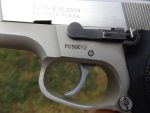 A lot of people, myself included, had a difficult time transitioning from that long DA trigger pull, to the follow-up SA trigger pull on handguns. It wasn’t the gun design, it was a training issue – just get out there and train using the DA transition to the SA transition – not a big deal. Most of today’s polymer-frame pistols are considered DA only – take it for what its worth – so each trigger pull is the same – no having to retrain your trigger finger.
A lot of people, myself included, had a difficult time transitioning from that long DA trigger pull, to the follow-up SA trigger pull on handguns. It wasn’t the gun design, it was a training issue – just get out there and train using the DA transition to the SA transition – not a big deal. Most of today’s polymer-frame pistols are considered DA only – take it for what its worth – so each trigger pull is the same – no having to retrain your trigger finger.
Today, it is still difficult to find handguns from the S&W Performance Center – most models are very limited editions. The owners of these guns tend to hold on to them. You can check around for one on many of the gun buying websites, but you’ll have a difficult time finding a Performance Center Shop Shorty .40 at any price. They are really nice guns!

